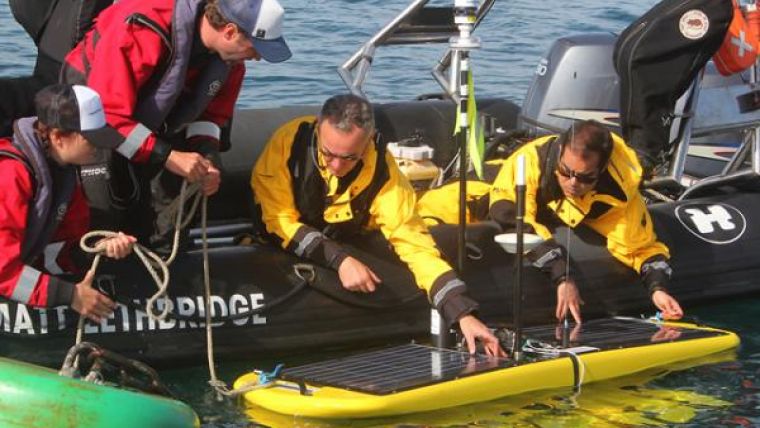Marine Robot Mission Underway off Northwest Scotland
An ambitious two-week mission involving ten marine robots has commenced off northwest Scotland. As the third in a series of demonstrator missions, this latest phase sees the largest fleet of marine robotic vehicles simultaneously deployed in UK waters. The mission comprises seven submarine gliders and three surface Wave Gliders that are working together in fleets to collect a range of environmental data.
The National Oceanography Centre (NOC, UK) started the ‘Exploring Ocean Fronts’ programme in 2014, working with partners across science, government and industry to field-test novel marine autonomous systems for long-endurance ocean monitoring.
Marine Life Mapping
Phase one saw a fleet of seven marine robots deployed from the Isles of Scilly, armed with sensors capable of monitoring marine life including plankton, fish, marine mammals and seabirds. The robots travelled up to 150km offshore, with one of the surface vehicles covering 450km in 12 days. Three of the surface vehicles were then redeployed in Marine Protected Areas offshore of Plymouth, where they successfully tracked tagged fish using novel acoustic receivers.
Phase two comprised two successive missions off southwest UK in 2015 and 2016, undertaken in partnership with World Wildlife Fund UK (WWF-UK) and Defence Science and Technology Laboratory (Dstl); these missions were used to further test how submarine gliders and unmanned surface vehicles can work together to observe relationships between ocean fronts and marine life.
Environmental Data Acquisition
This third phase is being run in partnership with the Scottish Association for Marine Science (SAMS) and is providing environmental data from an area off northwest Scotland to the Royal Navy’s ‘Unmanned Warrior’ marine robot demonstration. Real-time data are visible via the mission website, and will ultimately be available to the marine science community via the British Oceanographic Data Centre (BODC). Initial results will be presented at a workshop at the NOC in Southampton on 18 November 2016 as part of the annual Marine Autonomy and Technology Showcase.
As well as collecting basic information on ocean temperature, salinity, oxygen, turbidity, and near-surface weather conditions, the gliders will also be measuring ocean currents, water depth, and the abundance of plankton in hotspots such as water mass boundaries (fronts). Some of the vehicles will be travelling over 150km offshore of the Outer Hebrides, and venturing into waters up to a mile deep.
Most of the gliders will be piloted via satellite from an operations room in the Marine Robotics Innovation Centre at the NOC, but some project partners will be piloting their vehicles from as far away as the US and Australia. A primary objective of the mission is to maximise the amount of data transmitted back to the operations room in real-time, to ensure it can be used by Royal Navy and Dstl staff.
Lower Environmental Impact
NOC’s Professor Russell Wynn, chief scientist of the mission, expects that this deployment will showcase the capabilities of marine robots to the Royal Navy and other defence and industry partners. The results are also expected to inform the wider scientific and environmental community of the benefits of these new technologies as an alternative to manned vessels, which are relatively expensive to operate and have a larger environmental impact.

Value staying current with hydrography?
Stay on the map with our expertly curated newsletters.
We provide educational insights, industry updates, and inspiring stories from the world of hydrography to help you learn, grow, and navigate your field with confidence. Don't miss out - subscribe today and ensure you're always informed, educated, and inspired by the latest in hydrographic technology and research.
Choose your newsletter(s)
























